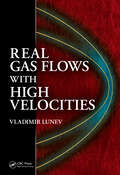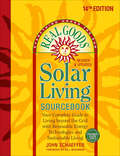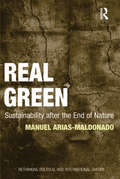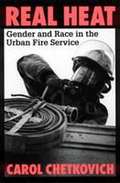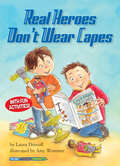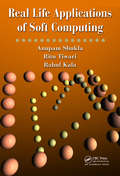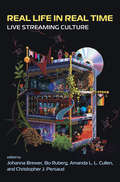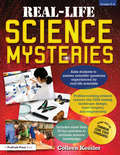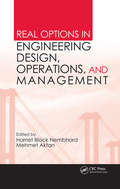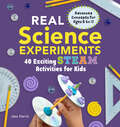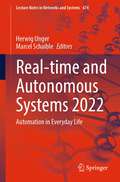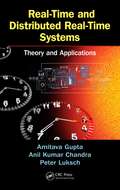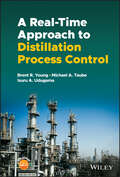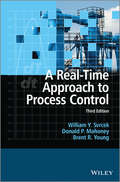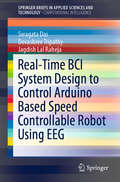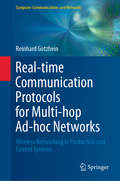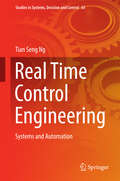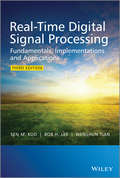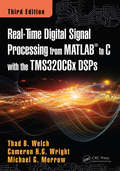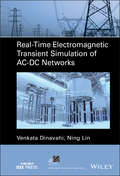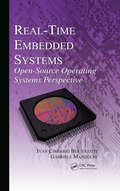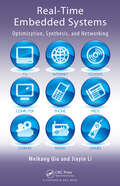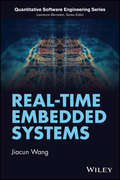- Table View
- List View
Real Food, Real Facts: Processed Food and the Politics of Knowledge
by Charlotte BiltekoffA free ebook version of this title is available through Luminos, University of California Press's Open Access publishing program. Visit www.luminosoa.org to learn more. In recent decades, many members of the public have come to see processed food as a problem that needs to be solved by eating "real" food and reforming the food system. But for many food industry professionals, the problem is not processed food or the food system itself, but misperceptions and irrational fears caused by the public's lack of scientific understanding. In her highly original book, Charlotte Biltekoff explores the role that science and scientific authority play in food industry responses to consumer concerns about what we eat and how it is made. As Biltekoff documents, industry efforts to correct public misperceptions through science-based education have consistently misunderstood the public's concerns, which she argues are an expression of politics. This has entrenched "food scientism" in public discourse and seeded a form of antipolitics, with broad consequences. Real Food, Real Facts offers lessons that extend well beyond food choice and will appeal to readers interested in how everyday people come to accept or reject scientific authority in matters of personal health and well-being.
Real Gas Flows with High Velocities
by Vladimir V. LunevDespite generations of change and recent, rapid developments in gas dynamics and hypersonic theory, relevant literature has yet to catch up, so those in the field are generally forced to rely on dated monographs to make educated decisions that reflect present-day science. Written by preeminent Russian aerospace researcher Vladimir V. Lunev, Real Ga
Real Goods Solar Living Sourcebook (Mother Earth News Books for Wiser Living)
by John SchaefferWhat book would you want if you were stranded on a desert island? Widely regarded as the "bible" of off-grid living, Real Goods Solar Living Source Book might be your best choice. With over six hundred thousand copies in print worldwide, it is the most comprehensive resource available for anyone interested in lessening their environmental footprint or increasing their energy independence.The Solar Living Sourcebook, Fourteenth Edition is the ultimate guide to renewable energy, sustainable living, natural and green building, off-grid living, and alternative transportation, written by experts with decades of experience and a passion for sharing their knowledge. This fully revised and updated edition includes brand new sections on permaculture and urban homesteading and completely rewritten chapters on solar technology, sustainable transportation, and relocalization. It also boasts greatly expanded material on: Natural building Permaculture and biodynamics Electric and biofuel-powered vehicles Passive solar Solar water heating Grid-tie photovoltaic systems--plus maps, wiring diagrams, formulae, charts, electrical code, solar sizing worksheets, and much more.Whether you're a layperson or a professional, novice or longtime aficionado, the Sourcebook puts the latest research and information at your fingertips--everything you need to know to make sustainable living a reality.John Schaeffer is the president and founder of Real Goods--the foremost global source for tools and information on renewable energy, energy efficiency, and sustainable living. Since 1978, through Real Goods, he has pioneered solar technology in North America, providing over one hundred and fifty megawatts of solar power and helping to solarize over eighteen thousand homes.
Real Green: Sustainability after the End of Nature (Rethinking Political and International Theory)
by Manuel Arias-MaldonadoWhat would a sustainable society look like? How could it be achieved? By challenging conventional wisdom about the ecological crisis and reframing the traditional values of green politics "Real Green; Sustainability after the End of Nature" offers new answers to the key questions of the environmental debate. In this ground-breaking and challenging work Manuel Arias-Maldonado convincingly argues that, since nature has now been transformed into a part of the human environment, it can be seen to no longer exist. Ecological problems thus become an inevitable and normal feature of our relationship with nature. Hence a post-natural environmentalism, realistic and liberal while remaining green, is advocated. In this framework, sustainability, democracy and liberalism become mutually reinforcing elements rather than conflicting ones. Only by combining them can a green society be realised.
Real Heat: Gender and Race in the Urban Fire Service
by Carol ChetkovichThirty years of legal and political efforts have opened the doors of this historically white male preserve, but men of color have yet to consolidate their gains, and women's progress has been even more tenuous. In this unique and compelling account of affirmative action at the "street level," Carol Chetkovich explores the ways in which this program has succeeded and failed.
Real Heroes Don't Wear Capes: Heroes (Social Studies Connects)
by Laura DriscollThe popular Social Studies Connects series links history, geography, civics and economics to kids&’ daily lives. Featuring stories with diverse characters who face situations young readers can relate to, these books support reading and social studies skills including researching, inferring, comparing, and communication. An activity to stimulate curiosity about the world is included in each book!With no special powers, no secret identity, and no cape, can someone be a real hero? Ethan thinks so and sets out to prove it! (Social Studies Topic: History & Culture/Heroes)
Real Life Applications of Soft Computing
by Anupam Shukla Ritu Tiwari Rahul KalaRapid advancements in the application of soft computing tools and techniques have proven valuable in the development of highly scalable systems and resulted in brilliant applications, including those in biometric identification, interactive voice response systems, and data mining. Although many resources on the subject adequately cover the theoreti
Real Life in Real Time: Live Streaming Culture
by Etal. Johanna BrewerThe cultural ramifications of online live streaming, including its effects on identity and power in digital spaces.Some consider live streaming—the broadcasting of video and/or audio footage live online—simply an internet fad or source of entertainment, yet it is at the center of the digital mediation of our lives. In this edited volume, Johanna Brewer, Bo Ruberg, Amanda L. L. Cullen, and Christopher J. Persaud present a broad range of essays that explore the cultural implications of live streaming, paying special attention to how it is shifting notions of identity and power in digital spaces. The diverse set of international authors included represent a variety of perspectives, from digital media studies to queer studies, from human-computer interaction to anthropology, and more.While important foundational work has been carried out by game studies scholars, many other elements of streaming practices remain to be explored. To deepen engagement with diversity and social justice, the editors have included a variety of voices on such topics as access, gender, sexuality, race, disability, harassment, activism, and the cultural implications of design aesthetics. Live streaming affects a wide array of behaviors, norms, and patterns of communication. But above all, it lets participants observe and engage with real life as it unfolds in real time. Ultimately, these essays challenge us to look at both the possibilities for harm and the potential for radical change that live streaming presents.
Real-Life Science Mysteries: Grades 5-8
by Colleen KesslerReal-Life Science Mysteries puts an exciting new spin on scientific thinking by profiling real-life scientists, showing students in grades 5-8 ways they can use science in their everyday lives. From a biologist studying the habits of garter snakes in Manitoba, Canada, to a landscape designer and greenhouse owner in Ohio, the scientists in this book share information and solutions to the thorniest problems they face in their scientific careers.With the more than 30 activities included in Real-Life Science Mysteries, students will be required to try their hand at solving common science problems and performing experiments while learning about real people from diverse backgrounds, all of whom share a love for discovering how they work, why things work, and how they can work better. This book is perfect for any science classroom or young scientists looking to increase their knowledge!Grades 5-8
Real Options in Engineering Design, Operations, and Management
by Harriet Black Nembhard Mehmet AktanGiven that engineering flexibility can potentially provide a competitive advantage, the question then becomes: Precisely how valuable is this flexibility? However, traditional methods often fail to accurately capture the economic value of investments in an environment of widespread uncertainty and rapid change. The real options method represents th
Real Process Improvement Using the CMMI
by Michael WestReal Process Improvement Using the CMMI (R) presents readers with non-academic, real-world approaches to process improvement via CMMI. The author provides concepts and techniques for CMMI-based process improvement which are as effective as they are innovative. Professionals at all levels from system engineers to CEOs will find a wealth of practical guidance and new ways to look at model-based process improvement that have already benefited large and small organizations in a variety of environments. Using plain language and enlightening illustrations, the author identifies the most critical concepts of the CMMI, and explains how to turn those concepts into real process improvement. This book provides you with key information that will significantly benefit all CMMI process improvement efforts. Topics include: * Ways to discover and understand the business goals and drivers for successful process improvement initiatives * How to recognize the structures and practices many organizations already have in place that can accelerate process improvement, even before they begin using the CMMI * Planning and managing the process improvement project * Innovative, untraditional yet highly effective and proven strategies for CMMI-based process improvement * A thorough debunking of many of the costly and wasteful myths surrounding CMMI-based improvement.
Real Science Experiments: 40 Exciting STEAM Activities for Kids (Real Science)
by Jessica HarrisTake your scientific exploration to the next level with real experiments for kids ages 8 to 12 Here's a hypothesis you can prove: science is a ton of fun! These science experiments for kids give you the opportunity to test this theory using 40 exciting activities that teach you all about science, technology, engineering, art, and math—the full STEAM package! From microscopes and candle-powered boats to insect mind control and hydroponics, these science experiments for kids offer a hands-on approach to scientific discovery. Each of these engaging and repeatable experiments give you the chance to get up-close, personal, and creative with all kinds of amazing ideas that will show you how to be a real scientist. This collection of science experiments for kids includes: STEAM for you—Take STEAM learning into your own hands with awesome, easy-to-do science experiments for kids that are perfect for doing at home. Science made simple—From hypothesis to observation to results, learn all about the power of the scientific method—and how you can use it every day. Hows and whys—Each of these science experiments for kids details exactly why things happen the way they do, helping you better understand the results you see. Take your first step into a world of scientific discovery with the help of these amazing science experiments for kids.
Real-time and Autonomous Systems 2022: Automation in Everyday Life (Lecture Notes in Networks and Systems #674)
by Herwig Unger Marcel SchaibleThis book contains the results of the researchers presented at this conference, which is supported by German Society of informatics (GI) and other organisations Real-Time Systems Expert Committees. The 43rd Real-Time Systems conference on "Automation in Everyday Life" is addressing an increasingly important topic in a world that is becoming more and more networked. The solutions presented here range from hardware to system design to individual applications. The target audience is students and researchers in computer science and automation technology (partly electrical engineering), engineers, programmers and users of automation and communication systems.
Real-Time and Distributed Real-Time Systems: Theory and Applications
by Amitava Gupta Anil Kumar Chandra Peter LukschDigital computers have revolutionized computation and transformed how computers are used to control systems in real life, giving birth to real-time systems. Furthermore, massive developments in the communications domain have made it possible for real-time systems to perform coordinated actions over communication interfaces, resulting in the evoluti
A Real-time Approach to Distillation Process Control
by Brent R. Young Michael A. Taube Isuru A. UdugamaA Real-Time Approach to Distillation Process Control A practical and hands-on discussion of modern distillation control In A Real-time Approach to Distillation Process Control, a team of distinguished researchers and industrial practitioners delivers a practical text combining hands-on and active learning using process simulation with discussions of the fundamental knowledge and tools required to apply modern distillation control principles. The book offers a balanced, real-time approach integrated with practical insights. It includes many exercises designed to be simulator agnostic that can be performed on the process simulator locally available to the reader. Readers will discover explorations of topics including distillation control hardware, distillation composition control, refinery versus chemical plant distillation control, distillation control tuning, advanced regulatory control, and more. They’ll also find: A thorough introduction to distillation fundamentals, as well as basic and advanced modern controls from a practical point of view Comprehensive explorations of known base controls combined with modern control practices Practical discussions of hands-on modelling and simulation exercises, allowing the reader to design and tune controls on a distillation column Fulsome treatments of control structure design integrated with controller tuning using a real-time approach Perfect for senior undergraduate and graduate students studying general process control or distillation process control, A Real-time Approach to Distillation Process Control will also benefit plant managers, production supervisors, startup supervisors, operations engineers, production engineers, and chemical engineers working in industry.
A Real-Time Approach to Process Control
by Donald P. Mahoney William Y. Svrcek Brent R. YoungWith resources at a premium, and ecological concerns paramount, the need for clean, efficient and low-cost processes is one of the most critical challenges facing chemical engineers. The ability to control these processes, optimizing one, two or several variables has the potential to make more substantial savings in time, money and resources than any other single factor. Building on the success of the previous editions, this new third edition of A Real-Time Approach to Process Control employs both real industry practice and process control education without the use of complex or highly mathematical techniques, providing a more practical and applied approach.Updated throughout, this edition:* Includes a brand new chapter on Model predictive Control (MPC)* Now includes wireless and web-based technologies* Covers bio-related systems* Details the new multivariable control measure developed by the authors* Includes PowerPoint slides and solutions to Workshop problems on the accompanying website: http://www.wiley.com/go/svrcek-real-time-3e From the reviews of previous editions:"Would appeal to practising engineers due to its "hands on" feel for the subject matter. But more importantly, the authors present these concepts as fundamentals of chemical engineering, in a way that is consistent with how professor teach at the universities." -Chemical Engineering Process (CEP)"The book has been beautifully crafted" -Engineering Subject Centre"Provides a refreshing approach to the presentation of process analysis and control" -The Chemical Engineer
Real-Time BCI System Design to Control Arduino Based Speed Controllable Robot Using EEG (SpringerBriefs in Applied Sciences and Technology)
by Swagata Das Devashree Tripathy Jagdish Lal RahejaThis book discusses the basic requirements and constraints in building a brain–computer interaction system. These include the technical requirements for building the signal processing module and the acquisition module. The major aspects to be considered when designing a signal acquisition module for a brain–computer interaction system are the human brain, types and applications of brain–computer systems, and the basics of EEG (electroencephalogram) recording. The book also compares the algorithms that have been and that can be used to design the signal processing module of brain–computer interfaces, and describes the various EEG-acquisition devices available and compares their features and inadequacies. Further, it examines in detail the use of Emotiv EPOC (an EEG acquisition module developed by Emotiv) to build a complete brain–computer interaction system for driving robots using a neural network classification module.
Real-time Communication Protocols for Multi-hop Ad-hoc Networks: Wireless Networking in Production and Control Systems (Computer Communications and Networks)
by Reinhard GotzheinThis book focuses on core functionalities for wireless real-time multi-hop networking with TDMA (time-division multiple access) and their integration into a flexible, versatile, fully operational, self-contained communication system. The use of wireless real-time communication technologies for the flexible networking of sensors, actuators, and controllers is a crucial building block for future production and control systems. WirelessHART and ISA 100.11a, two technologies that have been developed predominantly for industrial use, are currently available. However, a closer analysis of these approaches reveals certain deficits. Current research on wireless real-time communication systems shows potential to remove these limitations, resulting in flexible, versatile, and robust solutions that can be implemented on today’s low-cost and resource-constrained hardware platforms. Unlike other books on wireless communication, this book presents protocols located on MAC layer and above, and build on the physical (PHY) layer of standard wireless communication technologies.
Real Time Control Engineering
by Tian Seng NgThis book covers the two broad areas of the electronics and electrical aspects of control applications, highlighting the many different types of control systems of relevance to real-life control system design. The control techniques presented are state-of-the-art. In the electronics section, readers will find essential information on microprocessor, microcontroller, mechatronics and electronics control. The low-level assembly programming language performs basic input/output control techniques as well as controlling the stepper motor and PWM dc motor. In the electrical section, the book addresses the complete elevator PLC system design, neural network plant control, load flow analysis, and process control, as well as machine vision topics. Illustrative diagrams, circuits and programming examples and algorithms help to explain the details of the system function design. Readers will find a wealth of computer control and industrial automation practices and applications for modern industries, as well as the educational sector.
Real-Time Digital Signal Processing: Fundamentals, Implementations and Applications
by Sen M. Kuo Bob H. Lee Wenshun TianCombines both the DSP principles and real-time implementations and applications, and now updated with the new eZdsp USB Stick, which is very low cost, portable and widely employed at many DSP labs. Real-Time Digital Signal Processing introduces fundamental digital signal processing (DSP) principles and will be updated to include the latest DSP applications, introduce new software development tools and adjust the software design process to reflect the latest advances in the field. In the 3rd edition of the book, the key aspect of hands-on experiments will be enhanced to make the DSP principles more interesting and directly interact with the real-world applications. All of the programs will be carefully updated using the most recent version of software development tools and the new TMS320VC5505 eZdsp USB Stick for real-time experiments. Due to its lower cost and portability, the new software and hardware tools are now widely used in university labs and in commercial industrial companies to replace the older and more expensive generation. The new edition will have a renewed focus on real-time applications and will offer step-by-step hands-on experiments for a complete design cycle starting from floating-point C language program to fixed-point C implementation, code optimization using INTRINSICS, and mixed C-and-assembly programming on fixed-point DSP processors. This new methodology enables readers to concentrate on learning DSP fundamentals and innovative applications by relaxing the intensive programming efforts, namely, the traditional DSP assembly coding efforts. The book is organized into two parts; Part One introduces the digital signal processing principles and theories, and Part Two focuses on practical applications. The topics for the applications are the extensions of the theories in Part One with an emphasis placed on the hands-on experiments, systematic design and implementation approaches. The applications provided in the book are carefully chosen to reflect current advances of DSP that are of most relevance for the intended readership. Combines both the DSP principles and real-time implementations and applications using the new eZdsp USB Stick, which is very low cost, portable and widely employed at many DSP labs is now used in the new edition Places renewed emphasis on C-code experiments and reduces the exercises using assembly coding; effective use of C programming, fixed-point C code and INTRINSICS will become the main focus of the new edition. Updates to application areas to reflect latest advances such as speech coding techniques used for next generation networks (NGN), audio coding with surrounding sound, wideband speech codec (ITU G.722.2 Standard), fingerprint for image processing, and biomedical signal processing examples. Contains new addition of several projects that can be used as semester projects; as well as new many new real-time experiments using TI’s binary libraries – the experiments are prepared with flexible interface and modular for readers to adapt and modify to create other useful applications from the provided basic programs. Consists of more MATLAB experiments, such as filter design, algorithm evaluation, proto-typing for C-code architecture, and simulations to aid readers to learn DSP fundamentals. Includes supplementary material of program and data files for examples, applications, and experiments hosted on a companion website. A valuable resource for Postgraduate students enrolled on DSP courses focused on DSP implementation & applications as well as Senior undergraduates studying DSP; engineers and programmers who need to learn and use DSP principles and development tools for their projects.
Real-Time Digital Signal Processing from MATLAB to C with the TMS320C6x DSPs (Third Edition)
by Cameron H.G. Wright Michael G. Morrow Thad B. WelchThis updated edition gives readers hands-on experience in real-time DSP using a practical, step-by-step framework that also incorporates demonstrations, exercises, and problems, coupled with brief overviews of applicable theory and MATLAB applications. Organized in three sections that cover enduring fundamentals and present practical projects and invaluable appendices, this new edition provides support for the most recent and powerful of the inexpensive DSP development boards currently available from Texas Instruments: the OMAP-L138 LCDK. It includes two new real-time DSP projects, as well as three new appendices: an introduction to the Code Generation tools available with MATLAB, a guide on how to turn the LCDK into a portable battery-operated device, and a comparison of the three DSP boards directly supported by this edition.
Real-Time Electromagnetic Transient Simulation of AC-DC Networks (IEEE Press Series on Power and Energy Systems)
by Venkata Dinavahi Ning LinExplore a comprehensive and state-of-the-art presentation of real-time electromagnetic transient simulation technology by leaders in the field Real-Time Electromagnetic Transient Simulation of AC-DC Networks delivers a detailed exposition of field programmable gate array (FPGA) hardware based real-time electromagnetic transient (EMT) emulation for all fundamental equipment used in AC-DC power grids. The book focuses specifically on detailed device-level models for their hardware realization in a massively parallel and deeply pipelined manner as well as decomposition techniques for emulating large systems. Each chapter contains fundamental concepts, apparatus models, solution algorithms, and hardware emulation to assist the reader in understanding the material contained within. Case studies are peppered throughout the book, ranging from small didactic test circuits to realistically sized large-scale AC-DC grids. The book also provides introductions to FPGA and hardware-in-the-loop (HIL) emulation procedures, and large-scale networks constructed by the foundational components described in earlier chapters. With a strong focus on high-voltage direct-current power transmission grid applications, Real-Time Electromagnetic Transient Simulation of AC-DC Networks covers both system-level and device-level mathematical models. Readers will also enjoy the inclusion of: A thorough introduction to field programmable gate array technology, including the evolution of FPGAs, technology trends, hardware architectures, and programming tools An exploration of classical power system components, e.g., linear and nonlinear passive power system components, transmission lines, power transformers, rotating machines, and protective relays A comprehensive discussion of power semiconductor switches and converters, i.e., AC-DC and DC-DC converters, and specific power electronic apparatus such as DC circuit breakers An examination of decomposition techniques used at the equipment-level as well as the large-scale system-level for real-time EMT emulation of AC-DC networks Chapters that are supported by simulation results from well-defined test cases and the corresponding system parameters are provided in the Appendix Perfect for graduate students and professional engineers studying or working in electrical power engineering, Real-Time Electromagnetic Transient Simulation of AC-DC Networks will also earn a place in the libraries of simulation specialists, senior modeling and simulation engineers, planning and design engineers, and system studies engineers.
Real-Time Embedded Systems: Open-Source Operating Systems Perspective (Embedded Systems)
by Ivan Cibrario Bertolotti Gabriele ManduchiFrom the Foreword: "…the presentation of real-time scheduling is probably the best in terms of clarity I have ever read in the professional literature. Easy to understand, which is important for busy professionals keen to acquire (or refresh) new knowledge without being bogged down in a convoluted narrative and an excessive detail overload. The authors managed to largely avoid theoretical-only presentation of the subject, which frequently affects books on operating systems. … an indispensable [resource] to gain a thorough understanding of the real-time systems from the operating systems perspective, and to stay up to date with the recent trends and actual developments of the open-source real-time operating systems." —Richard Zurawski, ISA Group, San Francisco, California, USA Real-time embedded systems are integral to the global technological and social space, but references still rarely offer professionals the sufficient mix of theory and practical examples required to meet intensive economic, safety, and other demands on system development. Similarly, instructors have lacked a resource to help students fully understand the field. The information was out there, though often at the abstract level, fragmented and scattered throughout literature from different engineering disciplines and computing sciences. Accounting for readers’ varying practical needs and experience levels, Real Time Embedded Systems: Open-Source Operating Systems Perspective offers a holistic overview from the operating-systems perspective. It provides a long-awaited reference on real-time operating systems and their almost boundless application potential in the embedded system domain. Balancing the already abundant coverage of operating systems with the largely ignored real-time aspects, or "physicality," the authors analyze several realistic case studies to introduce vital theoretical material. They also discuss popular open-source operating systems—Linux and FreRTOS, in particular—to help embedded-system designers identify the benefits and weaknesses in deciding whether or not to adopt more traditional, less powerful, techniques for a project.
Real-Time Embedded Systems: Optimization, Synthesis, and Networking
by Meikang Qiu Jiayin LiUbiquitous in today's consumer-driven society, embedded systems use microprocessors that are hidden in our everyday products and designed to perform specific tasks. Effective use of these embedded systems requires engineers to be proficient in all phases of this effort, from planning, design, and analysis to manufacturing and marketing.Taking a sys
Real-Time Embedded Systems
by Jiacun WangOffering comprehensive coverage of the convergence of real-time embedded systems scheduling, resource access control, software design and development, and high-level system modeling, analysis and verification Following an introductory overview, Dr. Wang delves into the specifics of hardware components, including processors, memory, I/O devices and architectures, communication structures, peripherals, and characteristics of real-time operating systems. Later chapters are dedicated to real-time task scheduling algorithms and resource access control policies, as well as priority-inversion control and deadlock avoidance. Concurrent system programming and POSIX programming for real-time systems are covered, as are finite state machines and Time Petri nets. Of special interest to software engineers will be the chapter devoted to model checking, in which the author discusses temporal logic and the NuSMV model checking tool, as well as a chapter treating real-time software design with UML. The final portion of the book explores practical issues of software reliability, aging, rejuvenation, security, safety, and power management. In addition, the book: Explains real-time embedded software modeling and design with finite state machines, Petri nets, and UML, and real-time constraints verification with the model checking tool, NuSMV Features real-world examples in finite state machines, model checking, real-time system design with UML, and more Covers embedded computer programing, designing for reliability, and designing for safety Explains how to make engineering trade-offs of power use and performance Investigates practical issues concerning software reliability, aging, rejuvenation, security, and power management Real-Time Embedded Systems is a valuable resource for those responsible for real-time and embedded software design, development, and management. It is also an excellent textbook for graduate courses in computer engineering, computer science, information technology, and software engineering on embedded and real-time software systems, and for undergraduate computer and software engineering courses.

